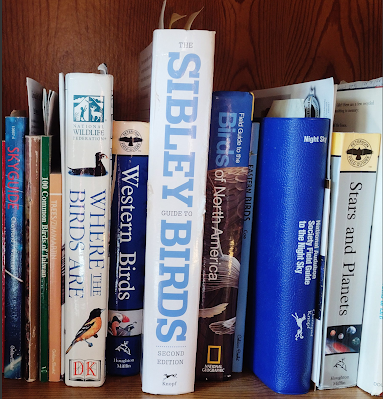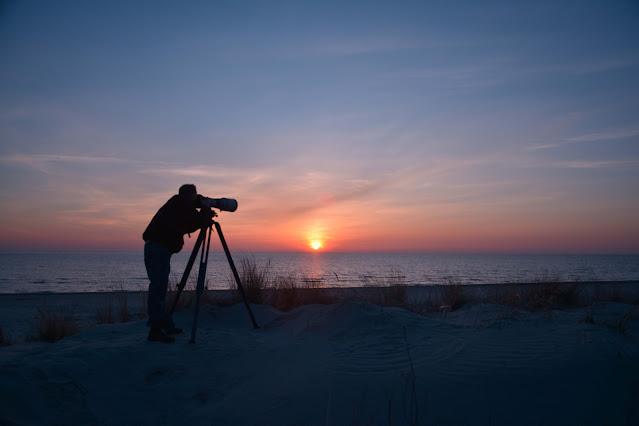Birding Tools of the Trade: The Basics
As I mentioned in my previous post, it doesn't take anything to get started with birding beyond your eyes, ears and a guidebook or app. Once you have a taste for the thrill of ID'ing a bird, you will likely want to add a few tools to help you further enhance your abilities. I'll break down the common equipment into basic and advanced categories. The basics require relatively modest investments in money and effort to use. The advanced are for more serious birding that require more money and time. This week covers the basics.
Note- Some Amazon links in here go through the Amazon associates program which may earn me a commission if purchased through the link but are otherwise not a paid promotion. Recommendations are based on my own purchase and use of the products.
The Basics
Guidebooks
A good, comprehensive guidebook is indispensable, and I strongly recommend collecting some of these. In my beginner days, I would carry a book in my backpack when I went out birdwatching and use it in real-time to try to figure out what I was looking at. These days I use an app on my phone
My preferred book is David Allen Sibley's "The Sibley Guide To Birds."
It covers North American species and, in addition to the incredibly detailed drawings, it has lots of other information for identifying each species.
I also have a few other guidebooks and sometimes, on a particularly tough identification challenge, I will need to consult them all and compare drawings and pictures to figure out what I am seeing.
Another tip is to get a book specific to the area you are going to be birding. Flipping through the hundreds of species in a full North America book may not make sense if you are birding in California. A condensed guidebook focused on the birds of California may be more helpful and easier to use. Similarly, I have purchased guidebooks for a particular location that I don't have coverage for, such as Hawaii and Taiwan and used them while on trips there.
Guide Apps
eBird
I use and recommend a couple of different apps for your phone. The e-Bird app is the best for logging sightings while in the field. Apple Link / Android Link. This 100% free app checks your location and downloads a checklist of expected birds for that area and date. It can record your track and time you spent birding. You record the numbers of each species you see and submit it into the e-bird database when complete. It allows you to submit observation notes for each species and you can follow up on their website to upload photos and sound recordings. If you really get into birding, you can select target species and see where around you they have been spotted recently so you can go try to find them. Your e-bird account tracks your life list as well as other lists (like my yard list) if you like to review your stats. This app is very polished and regularly updated and improved and it has evolved into a powerful, indispensable tool.
What e-bird does not do, however, is help you identify what you are looking at. For that, I use a couple of apps: Audubon Bird Guide (Android / Apple ) and Merlin Bird ID (Android / Apple ). Both are totally free and have large databases that can be downloaded to your phone, so they still work if you are in an area without cellular service.
Audubon Bird Guide
The Audubon app used to be my preferred app as it is very comprehensive and easy to use. You can search on parameters such as your state and the month to find likely species that you are looking at. You can put in the size, color, etc. of the bird you are looking at and it gives you likely matches that you can scroll through. It also suggests similar birds if what you see is close, but not an exact match. It has bird calls you can play as well to help with identification.
Merlin Bird ID
The Merlin app is coming on strong and I am using it more and more, particularly for its sound ID capabilities. Merlin started as a computer program using AI to identify bird species from a photo. The AI was trained using all of the user-submitted photos from e-bird. You could upload a photo to the website and it would attempt to tell you what species it was. They have now taken that technology and put it into an app and added the ability to ID birds by sound as well. I haven't used the photo ID much, but the sound ID is absolutely amazing!!!! The app uses your phone's microphone to record and listen to the bird calls around you. It converts the sound into an audiogram and uses AI to read the audiogram and tell you what bird is making the call in real-time. It sounds far-fetched but it actually works and works well. It isn't 100% accurate, but I'd guess it is in the high 90% range for accuracy. It is way better than me at identifying birds by sound. It has been a great tool for helping me learn bird calls as well. You absolutely have to give this app a try. It also has similar features to the Audubon app for searching for birds by characteristics.
Binoculars
I wouldn't go so far as to say that binoculars are a necessity, but they are a big help. My favorite size binoculars for birding are 8x42s. The first number is the magnification- 8 times magnification The second number is the lens diameter: 42mm diameter. Some people use 10x42 for birding, but I like the wider field of view from the 8x and have a harder time holding 10x steady. As for the lens diameter, larger is better in terms of how much light passes through the binoculars and how bright the image in the eyepiece will be. The tradeoff from larger lenses is, well, they are larger. That also means more weight. The 42mm is about at the sweet spot. Going larger doesn't make a significant difference in image brightness but going smaller does. Finally, birders tend to use roof prism binoculars rather than porro prism binoculars. This is primarily due to the smaller size of roof prisms. A quality binocular of either design will work fine.
I separate binoculars into 3 classes: low-end junk, mid-range stuff and high-end glass. Stay away from the $20 bins and others in the low-end junk. Some of that stuff might even use plastic lens elements instead of glass! For only a little bit more, you start getting into the mid-range binoculars where you get features key features like waterproofing. The mid-range also contains some relatively affordable options that have ED glass (extra low dispersion) that helps a lot with image sharpness. The mid-range price extends between about $60 and up to $500. Above that is the high end glass. The Zeiss, Leica and Swarovski binoculars, among others. They can get stupid expensive, like multiple thousands of dollars. I spent some time in a store comparing a $2000 Swarovski 8x42 to a $240 Vortex Diamondback HD 8x42 and couldn't tell any difference in image quality in the store. So, despite lusting after the high-end stuff, I can't recommend it (unless you are super rich, or looking for a Christmas present for me!) The marginal performance difference for each extra dollar spent at the high end is very, very tiny.
I spent a lot of time comparing specs on various binocular options and ended up with a spreadsheet tabulating it all to help visually determine what the best binoculars were for me based on my priorities. When I started this 7 or 8 years ago, the Vanguard Endeavor ED 8x42 were what I ended up going with. (There is a newer version, the Vanguard Endeavor ED II 8x42 of these now)

These are very comfortable binoculars with great optics and have served me well. They are comfortable to use, quick to focus, very bright and fully waterproof and shock proof. My only complaint about them is I sometimes have trouble aiming them when I first put them up to my face. I don't know if that is my problem or something about the binoculars that throws off my aim.
I updated the list recently (excerpt shown above) when I wanted to add another set to keep around the house to have handy when I see a bird out the window I want to ID. I didn't want to spend as much money on them this time, and there were some newcomers at lower prices this time around with great specs. This time, I selected the Celestron Nature DX ED 8x42.
These binoculars are an incredible value and are therefore my top recommendation for a good set of binoculars that should last you a lifetime. They seem to be as good optically as the Endeavors, but they aren't quite as comfortable to hold and adjust. That seems like a fair trade-off at nearly half the price. There is also a version without the ED glass that is even less expensive and should still be a very good binocular if you want to trim cost further. I would also recommend upgrading the binocular strap if you are going to spend a lot of time in the field with these. The Vanguard came with a very nice strap, but the Celestron models have a thin, uncomfortable strap that should be upgraded.
I also recently picked up a compact binocular for taking on backpacking trips. The 8x42s are a bit big and heavy for that, so I got a Kowa 10x25 for that purpose.
I got them on sale for $59.99 and wouldn't recommend spending more than that on a compact set. These are nowhere near as sharp or bright as the 8x42's mentioned above, but that is the sacrifice you make for smaller and lighter. Maybe. Zeiss makes some 10x25s that range from $300 to $900. Perhaps those sets can achieve great image quality in a small package. I haven't found any of those in a store to try out.
Conclusion
That's it for the basics. Not much $ investment is required to be a full-fledged birder! You can spend as little as $0 to get started. Around $100 will get you a top-of-the-line field guide and great set of binoculars that should last a lifetime. What a deal!
Stay tuned for next week's coverage of advanced equipment such as cameras and spotting scopes.












Very informative!!! All the info ever needed in one place for virdiing
ReplyDelete